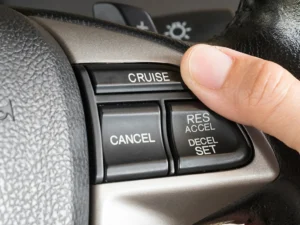Introduction to Cruise Control
Cruise control, a feature integrated into many modern vehicles, allows drivers to maintain a constant speed without manually controlling the throttle. It’s a convenient tool that enhances driving comfort and efficiency.
Understanding the Mechanics of Cruise Control
How Does Cruise Control Work?
Cruise control relies on sensors and an electronic control module to maintain a consistent speed set by the driver. These systems regulate the throttle or fuel flow to keep the vehicle cruising steadily.
Types of Cruise Control Systems There are various types, from basic systems that maintain a set speed to adaptive cruise control that adjusts speed based on traffic.
Efficiency Benefits of Using Cruise Control
Fuel Efficiency and Economy Cruise control optimizes fuel usage by ensuring a steady speed, enhancing overall fuel economy, and reducing unnecessary acceleration.
Consistency in Speed and Safety Maintaining a constant speed can improve safety by minimizing driver fatigue and allowing better focus on the road.

How to Use Cruise Control
Activating Cruise Control Engaging cruise control typically involves pressing a button or lever, followed by setting the desired speed. Each vehicle may have specific steps outlined in its manual.
Adjusting Speed and Deactivating Drivers can adjust the set speed or deactivate cruise control using controls usually located on the steering wheel or stalk.
Common Misconceptions about Cruise Control
Myths and Debunking There are myths surrounding cruise control, such as it only being suitable for highways or negatively impacting fuel efficiency, which need clarification.
Maintenance and Safety Considerations
Tips for Safe Usage Drivers should ensure they’re in an appropriate driving environment, avoiding using cruise control in adverse weather conditions or heavy traffic.
Maintenance Requirements Regular vehicle maintenance, including checking sensors and system functionality, is crucial for safe and efficient cruise control operation.

does cruise control save gas?
Cruise control is a convenient feature in many modern vehicles, designed to maintain a consistent speed without constant manual input from the driver. One common question among drivers is whether cruise control actually helps save gas.
The short answer is: yes, cruise control can contribute to fuel efficiency in certain situations. When engaged on relatively flat roads, cruise control keeps the vehicle moving at a steady pace, which can optimize fuel consumption by ensuring a consistent speed without unnecessary acceleration and deceleration.
The key advantage of cruise control lies in its ability to regulate throttle input more efficiently than a human driver in some scenarios. By maintaining a steady speed, the system can often deliver a more consistent fuel burn rate, which can result in better gas mileage compared to frequent manual speed adjustments.
However, the impact of cruise control on fuel savings may vary based on driving conditions. It tends to be most effective on highways or long stretches of relatively even terrain, where maintaining a constant speed is feasible. In contrast, in areas with frequent changes in elevation, traffic, or winding roads, the system may not operate optimally and could even lead to increased fuel consumption.
Moreover, the efficiency gains from using cruise control might not be significant in newer vehicles equipped with advanced engine management systems. These systems are designed to optimize fuel usage regardless of whether cruise control is engaged, narrowing the potential gap in fuel economy between manual and automated speed control.
In real-world driving, factors like traffic flow, weather conditions, and individual driving habits also influence fuel efficiency. While cruise control can aid in optimizing gas mileage under specific circumstances, it’s just one element among many that impact overall fuel consumption.
Ultimately, while cruise control can contribute to gas savings in appropriate conditions, drivers should also consider other fuel-saving practices like maintaining proper tire pressure, regular vehicle maintenance, and adopting smooth driving techniques to achieve optimal fuel efficiency.
Challenges and Limitations
Situations where Cruise Control may not be Ideal Certain scenarios, like hilly terrains or congested urban roads, may pose challenges for cruise control systems.
Addressing Challenges Technological advancements aim to address limitations and make cruise control adaptable to a wider range of driving conditions.
User Experiences and Feedback
Perspectives from Drivers Insights from drivers who regularly use cruise control offer valuable feedback on its convenience and effectiveness.
Surveys and Studies Studies and surveys delve into the impact and satisfaction levels of using cruise control across demographics.

Conclusion
In conclusion, cruise control has evolved from a simple speed maintenance system to a sophisticated driver assistance feature, enhancing both driving comfort and efficiency. As technology progresses, its integration with autonomous driving systems heralds a promising future.
FAQs on Cruise Control
Can cruise control improve fuel efficiency?
Is cruise control safe to use in all driving conditions?
Does cruise control work in manual transmission vehicles?
Can cruise control reduce driver fatigue?
Is cruise control suitable for city driving?
